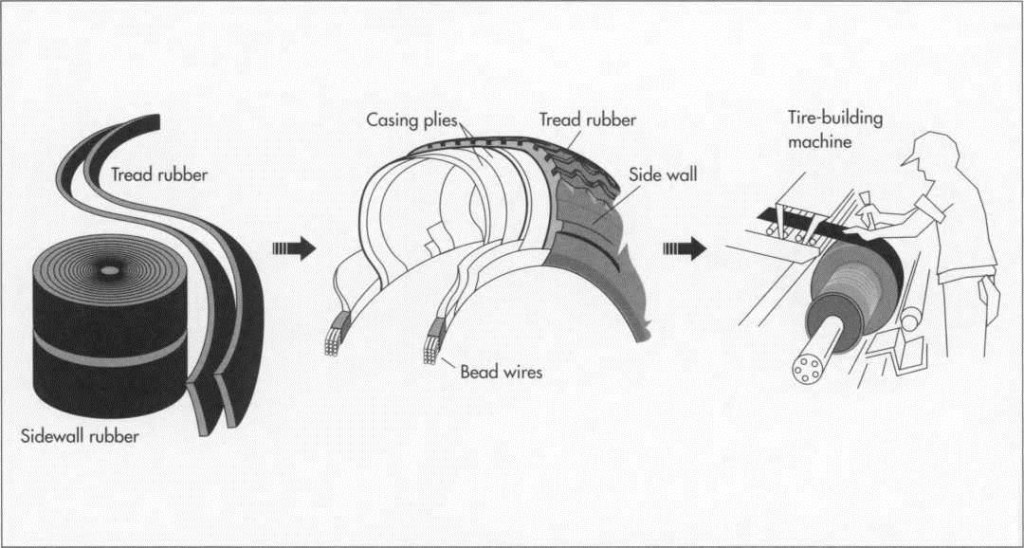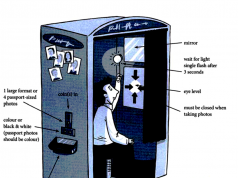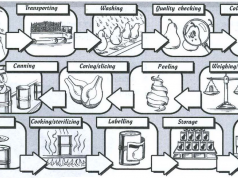
Background
A tire is a strong, flexible rubber casing attached to the rim of a wheel. Tires provide a gripping surface for traction and serve as a cushion for the wheels of a moving vehicle. Tires are found on automobiles, trucks, buses, aircraft landing gear, tractors and other farm equipment, industrial vehicles such as forklifts, and common conveyances such as baby carriages, shopping carts, wheel chairs, bicycles, and motorcycles. Tires for most vehicles are pneumatic; air is held under pressure inside the tire. Until recently, pneumatic tires had an inner tube to hold the air pressure, but now pneumatic tires are designed to form a pressure seal with the rim of the wheel.
Scottish inventor Robert Thomson developed the pneumatic tire with inner tube in 1845, but his design was ahead of its time and attracted little interest. The pneumatic tire was reinvented in the 1880s by another Scotsman, John Boyd Dunlop, and became immediately popular with bicyclists.
Natural rubber is the main raw material used in manufacturing tires, although synthetic rubber is also used. In order to develop the proper characteristics of strength, resiliency, and wear-resistance, however, the rubber must be treated with a variety of chemicals and then heated. American inventor Charles Goodyear discovered the process of strengthening rubber, known as vulcanization or curing, by accident in 1839. He had been experimenting with rubber since 1830 but had been unable to develop a suitable curing process. During an experiment with a mixture of India rubber and sulfur, Goodyear dropped the mixture on a hot stove. A chemical reaction took place and, instead of melting, the rubber-sulfur mixture formed a hard lump. He continued his experiments until he could treat continuous sheets of rubber.
Today, large, efficient factories staffed with skilled workers produce more than 250 million new tires a year. Although automation guides many of the steps in the manufacturing process, skilled workers are still required to assemble the components of a tire.
Raw Materials
Rubber is the main raw material used in manufacturing tires, and both natural and synthetic rubber are used. Natural rubber is found as a milky liquid in the bark of the rubber tree, Hevea Brasiliensis. To produce the raw rubber used in tire manufacturing, the liquid latex is mixed with acids that cause the rubber to solidify. Presses squeeze out excess water and form the rubber into sheets, and then the sheets are dried in tall smoke-houses, pressed into enormous bales, and shipped to tire factories around the world. Synthetic rubber is produced from the polymers found in crude oil.
The other primary ingredient in tire rubber is carbon black. Carbon black is a fine, soft powder created when crude oil or natural gas is burned with a limited amount of oxygen, causing incomplete combustion and creating a large amount of fine soot. So much carbon black is required for manufacturing tires that rail cars transport it and huge silos store the carbon black at the tire factory until it is needed.
Sulfur and other chemicals are also used in tires. Specific chemicals, when mixed with rubber and then heated, produce specific tire characteristics such as high friction (but low mileage) for a racing tire or high mileage (but lower friction) for a passenger car tire. Some chemicals keep the rubber flexible while it is being shaped into a tire while other chemicals protect the rubber from the ultraviolet radiation in sunshine.
Design
The main features of a passenger car tire are the tread, the body with sidewalls, and the beads. The tread is the raised pattern in contact with the road. The body supports the tread and gives the tire its specific shape. The beads are rubber-covered, metal-wire bundles that hold the tire on the wheel.
Computer systems now play a major role in lire design. Complex analysis software acting on years of test data allows tire engineers to simulate the performance of tread design and other design parameters. The software creates a three-dimensional color image of a possible tire design and calculates the effects of different stresses on the proposed tire design. Computer simulations save money for tire manufacturers because many design limitations can be discovered before a prototype tire is actually assembled and tested.
In addition to tests of tread design and tire body construction, computers can simulate the effects of different types of rubber compounds. In a modem passenger car tire, as many as twenty different types of rubber may be used in different parts of the tire. One rubber compound may be used in the tread for good traction in cold weather; another compound is used to give increased rigidity in the tire sidewalls.
After tire engineers are satisfied with computer studies of a new tire, manufacturing engineers and skilled tire assemblers work with the designers to produce tire prototypes for testing. When design and manufacturing engineers are satisfied with a new tire design, tire factories begin mass production of the new tire.
The Manufacturing Process
A passenger car tire is manufactured by wrapping multiple layers of specially formulated rubber around a metal drum in a tire- forming machine. The different components of the tire are carried to the forming machine, where a skilled assembler cuts and positions the strips to form the different parts of the tire, called a “green tire” at this point. When a green tire is finished, the metal drum collapses, allowing the tire assembler to remove the tire. The green tire is then taken to a mold for curing.
(The first step in the tire manufacturing process is the mixing of raw materials—rubber, carbon black, sulfur, and other materials—to form the rubber compound. After the rubber is prepared, it is sent to a tire- building machine, where a worker builds up the rubber layers to form the tire. At this point, the tire is called a “green tire.”)
The first step in the tire manufacturing process is the mixing of raw materials to form the rubber compound. Railcars deliver large quantities of natural and synthetic rubber, carbon black, sulfur, and other chemicals and oils, all of which are stored until needed. Computer control systems contain various recipes and can automatically measure out specific batches of rubber and chemicals for mixing. Gigantic mixers, hanging like vertical cement mixers, stir the rubber and chemicals together in batches weighing up to 1,100 pounds.
2 Each mix is then remilled with additional heating to soften the batch and mix the chemicals. In a third step, the batch goes through a mixer again, where additional chemicals are added to form what is known as the final mix. During all three steps of mixing, heat and friction are applied to the batch to soften the rubber and evenly distribute the chemicals. The chemical composition of each batch depends on the tire part—certain rubber formulations are used for the body, other formulas for the beads, and others for the tread.
Body, beads, and tread
3 Once a batch of rubber has been mixed, it goes through powerful rolling mills that squeeze the batch into thick sheets. These sheets are then used to make the specific parts of the tire. The tire body, for instance, consists of strips of cloth-like fabric that are covered with rubber. Each strip of rubberized fabric is used to form a layer called a ply in the tire body. A passenger car tire may have as many as four plies in the body.
4 For the beads of a tire, wire bundles are formed on a wire wrapping machine. The bundles are then formed into rings, and the rings are covered with rubber.
5 The rubber for the tire tread and sidewalls travels from the batch mixer to another type of processing machine called an extruder. In the extruder, the batch is further mixed and heated and is then forced out through a die—a shaped orifice—to form a layer of rubber. Sidewall rubber is covered with a protective plastic sheet and rolled. Tread rubber is sliced into strips and loaded into large, flat metal cases called books.
Tire-building machine
6 The rolls of sidewall rubber, the books containing tread rubber, and the racks of beads are all delivered to a skilled assembler at a tire-building machine. At the center of the machine is a collapsible rotating drum that holds the tire parts. The tire assembler starts building a tire by wrapping the rubber- covered fabric plies of the body around the machine drum. After the ends of these plies are joined with glue, the beads are added and locked into place with additional tire body plies laid over the beads. Next, the assembler uses special power tools to shape the edges of the tire plies. Finally, the extruded rubber layers for the sidewalls and tread are glued into place, and the assembled tire—the green tire—is removed from the tire-building machine.
Curing
7 A green tire is placed inside a large mold for the curing process. A tire mold is shaped like a monstrous metal clam which opens to reveal a large, flexible balloon called a bladder. The green tire is placed over the bladder and, as the clamshell mold closes, the bladder fills with steam and expands to shape the tire and force the blank tread rubber against the raised interior of the mold. During this curing process, the steam heats the green tire up to 280 degrees. Time in the mold depends on the characteristics desired in the tire.
*< After curing is complete, the tire is removed from the mold for cooling and then testing. Each tire is thoroughly inspected for flaws such as bubbles or voids in the rubber of the tread, sidewall, and interior of the tire. Then, the tire is placed on a test wheel, inflated, and spun. Sensors in the test wheel measure the balance of the tire and determine if the tire runs in a straight line. Because of the design and assembly of a modern tire, rarely is one rejected. Once the tire has been inspected and run on the test wheel, it is moved to a warehouse for distribution.
Quality Control
Quality control begins with the suppliers of the raw materials. Today, a tire manufacturer seeks suppliers who test the raw materials before they are delivered to the tire plant. A manufacturer will often enter into special purchasing agreements with a few suppliers who provide detailed certification of the properties and composition of the raw materials. To insure the certification of suppliers, tire company chemists make random tests of the raw materials as they are delivered.
Throughout the batch mixing process, samples of the rubber are drawn and tested to confirm different properties such as tensile strength and density. Each tire assembler is responsible for the tire components used. Code numbers and a comprehensive computer record-keeping system allow plant managers to trace batches of rubber and specific tire components.
When a new tire design is being manufactured for the first time, hundreds of tires are taken from the end of the assembly line for destructive testing. Some of the tires, for example, are sliced open to check for air pockets between body plies, while others are pressed down on metal studs to determine puncture resistance. Still other tires are spun rapidly and forced down onto metal drums to test mileage and other performance characteristics.
A variety of nondestructive evaluation techniques are also used in tire quality control. X-ray videography provides a quick and revealing view through a tire. In an X-ray tire test, a tire is selected at random and taken to a radiation booth where it is bombarded with X-rays. A test technician views the X- ray image on a video screen, where tire defects are easily spotted. If a defect shows up, manufacturing engineers review the specific steps of tire component assembly to determine how the flaw was formed.
In addition to internal testing, feedback from consumers and tire dealers is also correlated with the manufacturing process to identify process improvements.
The Future
Constant improvements in rubber chemistry and tire design are creating exciting new tires that offer greater mileage and improved performance in extreme weather conditions. Manufacturers now offer tires estimated to last up to 80,000 miles. Treads, designed and tested by computer, now feature unique asymmetrical bands for improved traction and safety on wet or snowy roads.
Tire design engineers are also experimenting with non-pneumatic tires that can never go flat because they don’t contain air under pressure. One such non-pneumatic tire is simply one slab of thick plastic attached to the wheel rim. The plastic curves out from the rim to a point where a rubber tread is secured to the plastic for contact with the road. Such a tire offers lower rolling resistance for greater fuel economy and superior handling because of a greater area of contact between tread and road.
Where To Learn More
Books
Kovac, F. J. Tire Technology. Goodyear Tire and Rubber Co., 1978.
Mechanics of Pneumatic Tires. U. S. Dept, of Transportation, 1981.
Periodicals
“Winners: The Best Product Designs of the Year,” Business Week. June 8, 1992, pp. 56¬57.
“Computer Simulation Saves Money, Enhances Tire Design Before Prototypes Are Built,” Elastomerics. July 1992, pp. 14-15.
“PZero: Pushing the Performance Envelope with Pirelli’s Newest Offering,” European Car. July, 1992, pp. 62-63.
“Tires: A Century of Progress,” Popular Mechanics. June 4, 1985, pp. 60-64.










